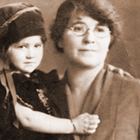Some Historical Notes
"In the present mood of mankind there are few persons to regret the destruction of works of art and the erasing of all vestiges of history... It is the more significant, therefore, that some account of them, together with a tribute to Charles Cameron, our forgotten countryman, should appear in this present time" - says Sacheverell Sitwell in his preface to Christopher Marsden's Palmyra of the North."
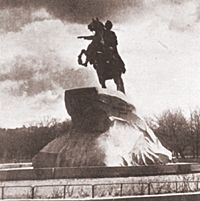 Left: PETRO PRIMO CATHARINA SECUNDA MDCCLXXXII. (Equestrian statue of Peter the Great mounted on a solid granite base, by Falconet.)
Left: PETRO PRIMO CATHARINA SECUNDA MDCCLXXXII. (Equestrian statue of Peter the Great mounted on a solid granite base, by Falconet.)
Those responsible for publishing this monograph therefore feel happy to be able, notwithstanding wartime difficulties, to present it to the English reader and to reestablish this delightful eighteenth-century link between Russia. and this country, especially at this time when, once again, so much depends on the brotherhood in arms of the two nations. Yet they feel that as it will take their reader to another century and to another country, a few pages should be devoted to an outline, however brief, of the time, the place and the personages who formed the background and created the opportunities which enabled Charles Cameron to become an "Ambassador of Art," and through his wonderful artistic creation, to score a triumph and example, the greatest yet known, of the expansion of English taste and English Art abroad.
Cameron, as will be seen, was invited to Russia by the Empress Catherine II.
 Left: Catherine the Great, copy by Argonov after an original by Lampi.
Left: Catherine the Great, copy by Argonov after an original by Lampi.
In 1746, as SOPHIE OF ANHALT-ZERBST, a sixteen-year-old princess belonging to a junior branch of German royalty, she went to St. Petersburg accompanied by her mother, at the invitation of the EMPRESS ELISABETH PETROVNA, to become the bride of the heir to the throne, the DUKE OF HOLSTEIN-GOTTORP, later PETER III. For sixteen years the young GRAND DUCHESS CATHERINE, as she was created, lived at the Court of Elisabeth, fitting herself in every way to fill worthily the position which gradually became her sole aim and aspiration. She embraced the faith of her adopted country, surrounded herself with Russian advisers, learnt not only to speak and read but also to write the language with perfection and, as she herself once wrote, set herself three tasks: to please her husband, to humour the Empress, and to make the Russian people happy. Shortly after Elisabeth's death, she succeeded in deposing her husband and, with the help of the guards, yet without a single shot being fired, ascended the throne which she occupied for thirty-three years, proving herself a true Successor of PETER THE GREAT and his tradition in her untiring labours as Ruler. A contemporary of GEORGE III, Louis XV and Louis XVI, FREDERICK THE GREAT, JOSEPH II and LEOPOLD II, she left an indelible mark in history as one of the outstanding figures of the century - CATHERINE THE GREAT.
As is mostly the case with great personalities, Catherine had time for everything: she attended the sitting of the Senate (the Cabinet of the time), received ambassadors, instructed her ministers, waged successful wars (NOTE:In 1781, a French emigrant, by the name of St. Jenis, had suggested to Catherine a plan for the conquest of India "from the English," or the purpose of restoring the dynasty of the Great Moguls, but Catherine rejected the plan as "fantastic."), and quelled a rising. Engaged in extensive correspondence with other monarchs as well as with a number of French philosophers, particularly Diderot and Voltaire, she founded the Free Economic Society for the study of agrarian problems, and offered 7,000 gold pieces for the best essay to find a practical solution "how to abolish serfdom without too much upsetting existing economic conditions." She convened the General Assembly (Legislative Chamber), for whom she herself wrote the NAKAZ (Instructions) (NOTE: The "Instructions" closed with these words: "Flatterers have instilled into all sovereigns upon earth this pernicious maxim: that their people are created for them only. But we esteem it our duty to declare that we are created for our people; for this reason we speak of things as they are, and have by this legislation intended to make Russia more just and happy than any other nation upon earth. To be disappointed in this our purpose would be a misfortune which we do not wish to survive."), and attended no fewer than 200 of its meetings. Believing that women should be given the same intellectual enlightenment as men, she completely revolutionised education and appointed PRINCESS DASHKOV, another remarkable woman, President of the Academy of Science, which, during that lady's fifteen years' term, did excellent work. Lastly, while occupied, with an amazing love for detail, with the general affairs of State, Catherine became a great patron of Art, and when she saw Cameron's book on the Roman Baths, she was so delighted with it that she immediately instructed her "Ambassador for Art," BARON GRIMM, to summon Cameron to her Court.
Curiously enough, one of the first tasks given to Cameron was to build baths. Now, baths had for centuries been a tradition and a habit in Russia. In old Muscovy it was not unusual for ministers to meet in the baths and discuss matters or State, thus combining work with healthy recreation, in striking contrast with the "Toilette du Roi," indeed a sorry performance. Moreover, when Versailles was being built, of brick and stone, in all its magnificence, as known to the world, it had no conveniences, let alone baths, yet at the same period ALEXIS, the second Romanov, concerned with the housing of his ever growing family outside Moscow, invited Italian builders to construct a country house of wood (KOLOMENSKOE), which contained not only baths for the members of the family, but also no fewer than three for the servants.
The reader may find it surprising that in Russia it should have been a woman who commanded a position so influential. Yet, as a matter of fact, the position of women in Russia at all times differed considerably from that in Western Europe. As far back as the eleventh century, the Russkaia Pravda (the then Code) provided equality of women before the law. No doubt the Tartar Yoke (from early thirteenth to late fifteenth century) was a great setback to her position, and only under Ivan the Third (1462-1505), who married SOPHIA PALEOLOGUE, the niece of the last Byzantine Emperor, CONSTANTINE, and such enlightened men as the Boyar MATVEIEV, did the position improve. Yet it took nearly a century of woman's rule (the eighteenth century) to restore to woman her rightful place. Those particularly interested in the subject would be well advised to read Marsden's book already quoted. Space does not permit any lengthy consideration of the subject, but a few lines are called for.
The first woman of note in Russian history was ST. OLGA (HELGA in Norse), who survived her husband IGOR, third King of Russia, and went to Byzantium, where she embraced the Holy Orthodox Faith. On her return to Kiev she must have had a following, as it is known that she built a church. She was thus the first Christian ruler (945-955) over a country which remained pagan for another thirty-three years until enlightened by the True Word in 988, by ST. VLADIMIR.
Kiev grew to great splendour, and Thietmar von Meresburg, who visited it in its heyday, describes it as a great city with 400 churches and markets, and Adam of Bremen speaks of it as the "rival of the shining glory of the East," i.e., Constantinople, with its Cathedral of St. Sophia, sumptuous palaces, a high level of culture, with libraries and schools where Greek and Latin were taught, and foreign artists invited. The Code of Laws, the Russkaia Pravda (Russian Truth), shows humane tendencies in advance of its times: there was no death penalty, economic and commercial matters were elaborately defined, and, as just mentioned, equality of women before the law was another remarkable aspect of Kievan life. YAROSLAV-THE-WISE (1015-1054), author of the Code, married his sister MARY to the King of Poland, his daughter ELISABETH to KING HAROLD HARDRADA of Norway, his second daughter ANASTASIE to KING ANDREW of Hungary, and his youngest daughter to KING HENRY I of France, where she is known as ANNE DE RUSSIE, REINE DE FRANCE. His son Vsevolod, who, according to the chronicler, was known as the most enlightened man of his time, knew five languages and "spake with Latins and Greeks in their tongue even as in his own." He married the daughter of CONSTANTINE MONOMACH, Emperor of Byzantium.
VLADIMIR MONOMACH (1113-1125) was married to AGATHA, daughter of HAROLD, the last Saxon King of England, and QUEEN EDITH, the widow of HAROLD II, with her court, found asylum in Russia.
However, notwithstanding this brilliant beginning, Kiev was exposed to the heavy curse of the persistent menace of Asia, and the idea that Russia's sacrifice in keeping back the destructive forces of Asia has saved Europe and assured her future hegemony, has not as yet sufficiently entered European historical thought. This lack of understanding between Western Europe and Russia, resulting from a flood of derogatory literature and mistaken conceptions, is manifest even today.
Much later, though barely fifty years after JOAN OF ARC was burnt at Rouen, MARTHA, the Possadnik, was the elected ruler of "THE LORD GREAT NOVGOROD," a powerful Russian Hansaic city, and gallantly defended that city from IVAN III(1472).
At the end of the seventeenth century, SOPHIA, the Regent during the infancy of her brothers, later the co-Tsars IVAN V and PETER I (1682-1689), strongly objected to intolerance and gave asylum to the persecuted Huguenots, although she remained on good terms with Louis XIV.
CATHERINE I (1725-1727), originally MARTHA SKAVRONSKAIA, a Latvian peasant girl by birth and nursery maid to a parson's children, later a captive of war, was married to Peter the Great in the Cathedral at St. Petersburg and crowned by him personally. It was, of course, Peter the Great who made women attend social functions, and Catherine I, when on the throne, issued instructions in regard to these "assemblies." It is worth noting such passages as, "Everyone shall be free to sit, walk or game as he pleases; nor shall anyone go about to hinder or to take exception... No ladies are to get drunk upon any pretence whatsoever, nor shall gentlemen be drunk before nine. Ladies who play at forfeitures, questions and commands shall not be noisy or riotous no gentleman shall attempt to force a kiss under pain of future exclusion."
After two ANNES (and PETER II and JOHN VI), almost immediately preceding Cameron's time, came ELISABETH (1741-1762), the daughter of PETER THE GREAT. She had made a vow not to shed blood, and after her accession liberated some 20,000 exiles and prisoners of previous reigns. She had inherited many of her father's statesmanlike qualities and 'the same power of discernment and insight into character. Although she is sometimes called the "Merry Empress Elisabeth," she proved herself a wise ruler. It was she who abolished capital punishment once and for all, and during the Seven Years' War she took the side of Austria against Frederick the Great, when the allied armies even entered Berlin.
Then follows the period connected with Cameron, opening up possibilities for men of talent and skill, the field of a progressive country as Russia was.
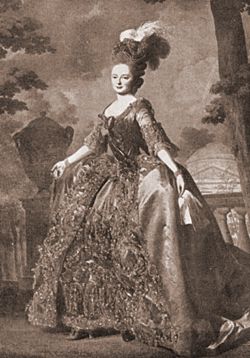 Right: Empress Marie Feodorovna, painting by Roslin
Right: Empress Marie Feodorovna, painting by Roslin
Along with work for Catherine, Cameron also worked for the GRAND DUKE PAUL and his wife, then the GRAND DUCHESS MARIE. In this book is reproduced a portrait of Paul, as Emperor, from a contemporary painting, in the robes of Grand Master of the Order of St. John of Jerusalem. This dignity, of which lie was very proud, had been conferred upon him in 1798 by one-half of the Knights expelled from Malta by Napoleon. He clung to it tenaciously, and distributed the Order freely, in spite of the opposition of both England, and the Pope, who could not reconcile himself with the idea that an Orthodox Monarch should be at the head of a Roman Catholic Order!
Paul's wife, later the EMPRESS MARIE FEODOROVNA (the first) certainly was able to appreciate Cameron, as she herself was an artist, and in this book is reproduced a table ornament in ivory, made by her after Cameron's design; but she is best remembered by her understanding mind and heart for her work for charity on a nation-wide scale. She inaugurated the so-called Institutions of the Empress Marie, which developed into a vast vast independent department, a sort of Ministry of Health, Public Welfare and Board of Education combined. It included alms and workhouses, boys' and girls' schools, as well as maternity houses, where any unfortunate mother could give birth to and leave her offspring knowing that it would have care, a name (usually derived from the name of the reigning monarch) and a chance to do well in life.
 Right: Alexander I
Right: Alexander I
The last reign connected with Cameron's work was that of Alexander I, surnamed "The Blessed," and also "The First Gentleman of Europe." No doubt he is known in this country, so perhaps one should only remind the reader that he visited England in 1815, after his triumphal entry into Paris at the head of the Allied Powers, who defeated Napoleon. There is a commemoration column, surmounted by an angel, similar to the Alexander Column in the Palace Square, St. Petersburg, erected on the Isle of Wight, above St. Catherine's point.
A few words should also be said about the places mentioned throughout this book, particularly Tsarskoe Selo and Pavlovsk.
TSARSKOE SELO, often referred to as TSARSKOE, is about fifteen miles south of the former Russian capital. It was Peter the Great's Consort, Catherine I, who, during one of her husband's many travels and wars, selected the spot and built a country house, with a garden, as a surprise for him on his return. Its original name, in Finnish, was SAARI MOJS (High Place). Saari, adapted into Russian, became "SARSKOE," which, in its turn, perhaps partly through phonetic assonance, soon became "TSARSKOE SELO," or "Tsar's Village," and since the middle of the eighteenth century it was the usual Imperial residence, a Russian Windsor. After the revolution it was renamed DETSKOE SELO (Children's Village), but later again renamed " Pushkino," after the Russian poet Pushkin, who was educated at the ALEXANDER LYCEUM, then at Tsarskoe. It was in the fighting zone all through the summer of 1941 and since, and seems to have been severely damaged.
PAVLOVSK, only a mile or two further south, which took its name from Paul I, developed later into a charming residential Garden City, and in recent decades was the seat of the CONSTANTINOVITCH branch of the Imperial House. It also supplied the lovely setting for symphony concerts which were given daily every summer in a lofty hall of perfect acoustics, built in the Pavlovsk Railway Station, an altogether delightful wooden structure. The audience, undisturbed during the performance, could enjoy fresh air in the intervals and walk round the flower beds and playing fountains, or along the graceful semicircular wing promenades. Of damage to Pavlovsk nothing is known, so one may yet hope that some of its beauties will survive.
The other places - BAKHTCHISARAT, BATOURIN and LIALITCHI - are in the CRIMEA and the UKRAINE, and as far as is known are intact and still retain their original names.
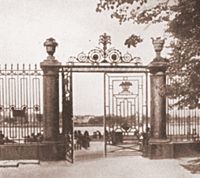 LEFT: A gate to the Summer Garden, St. Petersburg. Wrought Iron, partly gilded, and Granite Pillars (Velten, 1765-1770).
LEFT: A gate to the Summer Garden, St. Petersburg. Wrought Iron, partly gilded, and Granite Pillars (Velten, 1765-1770).
Those responsible for the publication of this book have spared no effort to include as many illustrations as war times permit. Most of these, of course, present Cameron's work, but so that it should not appear isolated, a few more plates have been added to give a glimpse of what was done by his predecessors, contemporaries, and those who came after him. Thus, it is felt, Cameron's work is presented in its proper surroundings, giving it shape and historical perspective.
Many English and other foreign visitors to Russia in the last twenty years may have seen the national art treasures and would testify that all possible care was taken to preserve this inheritance. It remains to be hoped that the battles which for over two years have been raging in the very vicinity of Tsarskoe and Pavlovsk will have spared the lovely creations of men, like Cameron, imbued with artistic vision, so that lovers of art and beauty may continue to admire and derive inspiration from their work in the future.
THE EDITOR, 1943.
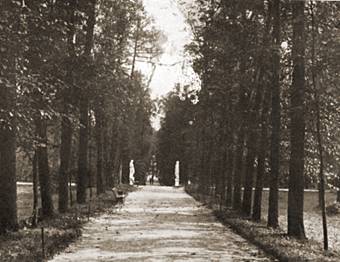
Above: The Summer Graden in St. Petersburg.
Please send your comments on this page to Bob Atchison
